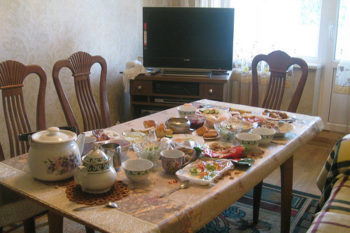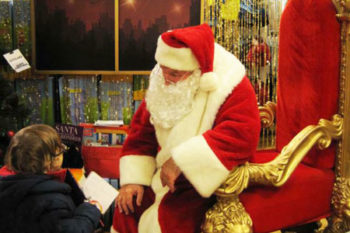I’d been watching the city municipal workers assemble the rows of wooden stalls and the three-story Christmas tree in Wrocław’s town center since the middle of November. The outdoor Christmas market seemed like it was going to be a huge event. Sprawled across two lengths of the square, the builders worked just as hard at assembling as they did at shoveling the continually on-coming snow heralding the beginning of the Polish winter.
I knew the day the market opened by the smell. Fried kielbasa, baked gingerbread, and the distinct linger of hot mulled wine invited me in as I walked from my bus stop toward the building where I work. Luckily, the town square is positioned so that a detour through the market was, actually, right on the way.

I spent my first walk through the market hovering around the rows of stalls, and couldn’t resist the one selling warm mugs of spiced wine. The drink functioned as both cozy beverage and a hand-warmer, and I wished there was an equally pleasant way to warm my slowly numbing feet. The temperature had been hovering around minus 10 degrees all week.
Walking through the market did more than boost my sensory input and numb my feet, though. It pulled together a slew of sensations that walked the line between memories and nostalgia. It reminded me of America, and the traditions I grew up with as a child. It reminded me of Germany, where I spent last Christmas. But the constant underlying reminder was the one that kept whispering, “You’re living in Poland now.”
It also made me think about traditions.
Though traditions may seem like timeless and immovable patterns, breakable only at the expense of society falling to pieces, they are actually quite the opposite. Traditions are adaptable, flexible, and constantly changing to fit the time and place in which they exist.
As I watched Wrocław residents and tourists alike snapping photos of the newly-opened market stalls and the life-sized reindeer and sleigh, I couldn’t help wondering, will people look back at these photos and connect them with the idea of Polish traditions? The market is indeed a local Wrocław tradition, and does incorporate many Polish Christmas traditions. But it’s bigger than that. It overlaps with traditions from other parts of Europe and from America, combining to create a flexible framework that probably changes a little bit every year.
 Christmas markets have a multiple-century history, originating in German-speaking parts of Europe from the late middle-ages onward. The market in Dresden, Germany, is one of the oldest in the world, dating from the mid-1400s. Last year, I spent Christmas Eve wandering through the dozens of Christmas markets in Berlin. The faux wooden stands of Wrocław’s market, the distinct smell of frying sausage and the children’s carnival rides are a mirror reflection of the markets I experienced last year. It’s only been a recent development, within the past two decades or so, that the Christmas market tradition has begun to spread across Slavic-speaking Europe. So it’s no surprise that there would be such an overlap, and that a wander through the Wrocław market would remind me of the lasting impressions from Berlin’s markets.
Christmas markets have a multiple-century history, originating in German-speaking parts of Europe from the late middle-ages onward. The market in Dresden, Germany, is one of the oldest in the world, dating from the mid-1400s. Last year, I spent Christmas Eve wandering through the dozens of Christmas markets in Berlin. The faux wooden stands of Wrocław’s market, the distinct smell of frying sausage and the children’s carnival rides are a mirror reflection of the markets I experienced last year. It’s only been a recent development, within the past two decades or so, that the Christmas market tradition has begun to spread across Slavic-speaking Europe. So it’s no surprise that there would be such an overlap, and that a wander through the Wrocław market would remind me of the lasting impressions from Berlin’s markets.
Despite the German influences, the market was simultaneously Polish as well. Multiple stalls advertised pierogi and kiełbasa. One stall specialized in naleśniki, Polish pancakes. Another sold the various types of fish that are the staple component of a Polish Christmas Eve dinner.
 The market was also marked as distinctly local – distinctly Wrocławian – by the life-sized gnome guarding the entrance. Gnomes play a large role in creating local identity in Wrocław. They were inspired by a local leader of Solidarity, the movement which, during the 1980s, united people around the country in countering, and eventually overthrowing, the Communist government. Small gnome sculptures hide throughout the town square, a reminder of the city’s more recent history.
The market was also marked as distinctly local – distinctly Wrocławian – by the life-sized gnome guarding the entrance. Gnomes play a large role in creating local identity in Wrocław. They were inspired by a local leader of Solidarity, the movement which, during the 1980s, united people around the country in countering, and eventually overthrowing, the Communist government. Small gnome sculptures hide throughout the town square, a reminder of the city’s more recent history.
On the other side of the market, I noticed American-inspired commercialism seeping in (the kind that has been adopted and modified and made local around the world). I felt as though I was walking through the mall in the suburban Cleveland town in which I grew up. One stall sold knick-knack angels and ornaments with the inevitable made-in-china sticker hiding at the bottom. Another sold Hot Topic-esque tshirts and hookahs.
As I walked past the stall selling carp, I was reminded of a conversation I’d had with a few of my students, comparing Christmas traditions. As a fourth-generation American of Polish descent, my family still uses some Polish traditions to shape our own holiday patterns. The topic of our conversation overlapped, criss-crossing here and there as we described our respective Christmas Eve traditions.
In Poland, Christmas Eve (Wigilia) – 24th December – is the most important day of the holiday season. As a child, I’d always been aware that most people in America didn’t celebrate Christmas like we did. While most of my childhood friends counted the days until Christmas morning – 25th December, when they’d open the stack of presents under the tree, I counted the days until Christmas Eve, when my family ate pierogi and opened gifts before attending midnight church service.
But sometimes the comparisons in our conversation veered away from each other as well. My family has modified and adapted many Polish traditions to better fit patterns in America. For example, one staple Christmas dish in Poland is carp. Many of my Polish students have memories – some distant childhood memories, some annually-occurring ones – of buying the carp live and providing it a bathtub-habitation for a few days before Christmas Eve. Such a vast difference from the honey-baked ham that accompanies the pierogis on my family’s dinner table.
The market stalls began to taper off as my feet continued to grow colder and colder. Passing by the sparkling Christmas tree that marked the end of the market, I stepped back into the pattern of my regular day, and continued my walk to work.

Read more:
It’s Christmas in Chicago!
Christmas traditions in other countries, from PocketCultures contributors around the world





Thanks for this Jenna. It looks lovely in the photos, but I bet it’s cold there! Manchester in the UK has started holding Christmas markets in the last few years. I think they were inspired by the German and Eastern European ones. It’s interesting to read that you can see American influence in the Polish markets, whilst Sean wrote last week about US traditions which originate in Germany!
Wroclaw seems beautiful in your photos!
I like Christmas Markets very much! I visited some of them in Germany two years ago! It’s a kind of magic!
This year I went to Valkenburg in the Netherlands.
How interesting the life-sized Gnome origins!
I remember to see Lech Walesa on TV in the 80’s 😉
Happy 2011!!